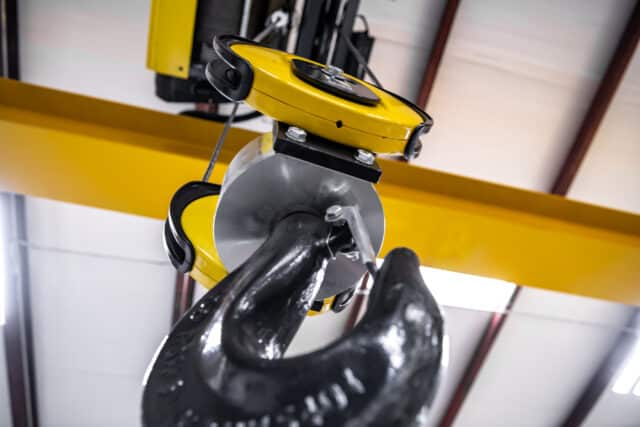Crane hooks are one of the most important components in any overhead lifting system. Hooks endure constant use and heavy loads which makes them prone to wear, deformation, or fatigue over time. Knowing when to replace a crane hook is essential for your safety and production.
At Engineered Systems, we prioritize safety by aligning all inspections, services, and replacements with OSHA and ASME B30.10 standards.

Visual Signs a Hook Needs Replacement
Routine inspections are critical for preventing hook failure. The following are signs that require immediate attention:
- Excessive Wear – If wear on the hook exceeds 10% of its original dimension, the hook is to be replaced.
- Deformation or Bending – Any bending, twisting, or distortion in the hook reduces its strength and can lead to failure.
- Visible Surface Cracks – Any crack, regardless of the size, is a clear indicator that the hook is no longer structurally sound.
- Damaged or Missing Latch – The latch is a critical safety component of the hook assembly that keeps loads and slings securely in place. If there is a malfunctioning or absent latch, it must be replaced immediately, though this does not always require replacing the entire hook itself.
- Excessive Increase in Throat Opening – A throat opening that has increased by more than 5% should be inspected and removed.
- Condition of Pins and Bolts – Ensure all pins and bolts are securely in the hook. Improper attachments can lead to serious failure and conditions.
Inspection Standards and Requirements
Based on ASME B30.10 and OSHA standards, hook inspections are mandatory.
Inspection Types:
- Preoperational Inspections – Visual and audible operational examination of the hoist and shall be conducted before the hoist is first used during each shift.
- Frequent Inspections – Visual and audible examination of the hoist performed at intervals of daily to monthly depending on characteristics of use.
- Periodic Inspections – Conducted by a certified professional based on usage and application, monthly to annually.
Consequences of Ignoring Signs
Failing to replace a damaged crane hook can result in:
- Serious injuries or fatalities
- Shutdowns or costly delays
- OSHA or ASME compliance violations
- Damage to load or equipment
- Decrease in customer confidence and reputation
Engineered Systems helps customers maintain compliance and reduce risk through routine inspections, expert service, and replacement solutions. We abide by OSHA 1910.179, and ASME B30 standards to ensure every hook in your facility is safe and certified to perform.

